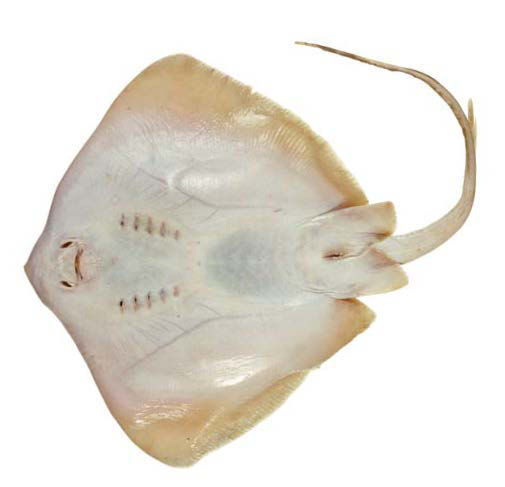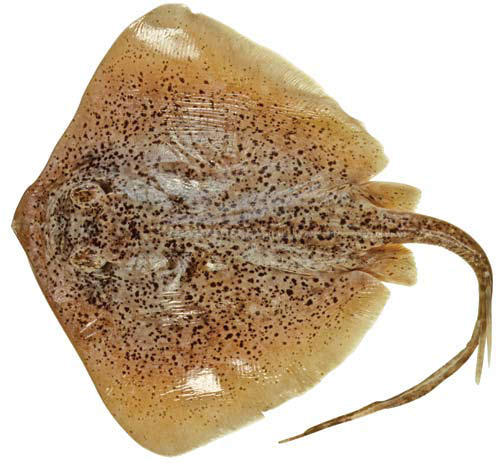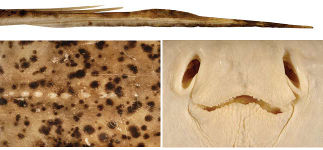Neotrygon picta
Last & White, 2008
Peppered maskray
Classification: Elasmobranchii Myliobatiformes Dasyatidae
Reference of the original description
Resurrection of the genus Neotrygon Castelnau (Myliobatoidei: Dasyatidae) with the description of Neotrygon picta sp. nov., a new species from northern Australia. CSIRO Marine and Atmospheric Research Paper, 22, 315–326
Resurrection of the genus Neotrygon Castelnau (Myliobatoidei: Dasyatidae) with the description of Neotrygon picta sp. nov., a new species from northern Australia. CSIRO Marine and Atmospheric Research Paper, 22, 315–326
Image of the original description

Neotrygon picta sp. nov, female holotype (CSIRO H 5771–01, 236 mm DW, fresh): ventral view. In: Last, P.R. & White, W.T. (2008): Resurrection of the genus Neotrygon Castelnau (Myliobatoidei: Dasyatidae) with the description of Neotrygon picta sp. nov, a new species from northern Australia. CSIRO Marine and Atmospheric Research Paper, 22: 315-326

Neotrygon picta sp. nov, female holotype (CSIRO H 5771–01, 236 mm DW, fresh): ventral view. In: Last, P.R. & White, W.T. (2008): Resurrection of the genus Neotrygon Castelnau (Myliobatoidei: Dasyatidae) with the description of Neotrygon picta sp. nov, a new species from northern Australia. CSIRO Marine and Atmospheric Research Paper, 22: 315-326
Synonyms / new combinations and misspellings
Neotrygon cf. picta
Neotrygon cf. picta
Types
Neotrygon picta
Holotype: CSIRO: H 5771-01; Paratype: CSIRO: H 3385-01; CSIRO: H 3361-07; CSIRO: H 3333-03; CSIRO: H 2376-07; CSIRO: H 2376-06; CSIRO: H 1218-01; CSIRO: H 5590-02; CSIRO: H 3895-01; CSIRO: H 3374-06; CSIRO: H 3374-05; CSIRO: H 3332-02; NTM: S 16597-001;
Neotrygon picta
Holotype: CSIRO: H 5771-01; Paratype: CSIRO: H 3385-01; CSIRO: H 3361-07; CSIRO: H 3333-03; CSIRO: H 2376-07; CSIRO: H 2376-06; CSIRO: H 1218-01; CSIRO: H 5590-02; CSIRO: H 3895-01; CSIRO: H 3374-06; CSIRO: H 3374-05; CSIRO: H 3332-02; NTM: S 16597-001;
Description :
Citation: Neotrygon picta Last & White, 2008: In: Database of modern sharks, rays and chimaeras, www.shark-references.com, World Wide Web electronic publication, Version 05/2025
Please send your images of "Neotrygon picta" to info@shark-references.com

Neotrygon picta sp. nov, female holotype (CSIRO H 5771–01, 236 mm DW, fresh): dorsal view; In: Last, P.R. & White, W.T. (2008): Resurrection of the genus Neotrygon Castelnau (Myliobatoidei: Dasyatidae) with the description of Neotrygon picta sp. nov, a new species from northern Australia. CSIRO Marine and Atmospheric Research Paper, 22: 315-326

Neotrygon picta sp. nov, female holotype (CSIRO H 5771–01, 236 mm DW, fresh): dorsal view; In: Last, P.R. & White, W.T. (2008): Resurrection of the genus Neotrygon Castelnau (Myliobatoidei: Dasyatidae) with the description of Neotrygon picta sp. nov, a new species from northern Australia. CSIRO Marine and Atmospheric Research Paper, 22: 315-326
Common names
 Peppered maskray
Peppered maskray
 Peppered maskray
Peppered maskray
Short Description
Original diagnosis after LAST & WHITE, 2008 [3356]: A small dasyatid (reaching 27 cm DW) with the following combination of characters: disc quadrangular, broader than long, width about 1.2 times length; variably peppered dorsally with an irregular scattering of asymmetric black spots but lacking blue spots; snout broadly triangular, angle 113–124°, snout length 1.7–2.1 times interorbital width; preoral length 2.1–2.6 times mouth width; internasal distance 1.3–1.4 in prenasal length; interspiracular distance 13.2–14.6% DW; nostril length 3.2–3.6% DW; nasal curtain width 8.8–9.9% DW; mouth width 7.1–8.1% DW; body and tail mostly naked; 0–22 thornlets in single continuous row along midline of disc; pectoral-fin radials 101–105; total vertebral centra (including synarcual) 113–122, trunk centra (including synarcual) 37–40.
Diet: north-east Australia (data base: 310 specimens): Carids were identified as the most important prey category (82,0 %IRI), with polychaetes the second most important prey category (15,0 %IRI) [14696]
Original diagnosis after LAST & WHITE, 2008 [3356]: A small dasyatid (reaching 27 cm DW) with the following combination of characters: disc quadrangular, broader than long, width about 1.2 times length; variably peppered dorsally with an irregular scattering of asymmetric black spots but lacking blue spots; snout broadly triangular, angle 113–124°, snout length 1.7–2.1 times interorbital width; preoral length 2.1–2.6 times mouth width; internasal distance 1.3–1.4 in prenasal length; interspiracular distance 13.2–14.6% DW; nostril length 3.2–3.6% DW; nasal curtain width 8.8–9.9% DW; mouth width 7.1–8.1% DW; body and tail mostly naked; 0–22 thornlets in single continuous row along midline of disc; pectoral-fin radials 101–105; total vertebral centra (including synarcual) 113–122, trunk centra (including synarcual) 37–40.
Diet: north-east Australia (data base: 310 specimens): Carids were identified as the most important prey category (82,0 %IRI), with polychaetes the second most important prey category (15,0 %IRI) [14696]
Remarks
shark-references Species-ID=4119;
shark-references Species-ID=4119;
Parasites (arranged by Jürgen Pollerspöck)
Cestoda
Cestoda
- Proemotobothrium linstowi (Southwell, 1912) [17827]
















